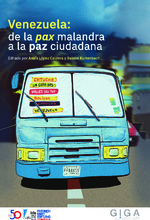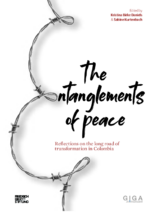PEACEptions
The Project
Willy Brandt's inspiring statement: "Peace is not everything, but without peace everything is nothing" has postulated "peace" as a goal. So have many Sunday speeches and declarations in international and national politics, like a thread running through time and space. But there are different concepts of peace as well as answers to the question of how to achieve and maintain peace.
The joint project PEACEptions conducted by the German Institute for Global and Area Studies (GIGA) and the Friedrich-Ebert-Stiftung (FES) provides a conceptual framework in which different ideas of peace – ranging from the absence of war up to fundamental socio-political transformations – can be highlighted and their differences analysed in order to be able to formulate concrete proposals for peacebuilding. The selected countries (Cameroon, Colombia, the Philippines, South Sudan, Tunisia and Venezuela) show variations across conflict topics and manifestations of violence – from open war to state repression.
Our underlying concept of peace as a "process of constructive conflict transformation" is based on three elements that are central to any social order and relevant to peace across historical and cultural contexts:
- security
- participation and
- institutions to transform conflicts.
This conceptual framework in which different ideas of peace can be highlighted and their differences analysed enables us to formulate concrete proposals for peacebuilding, which is at the heart of the project.
Contact
Friedrich-Ebert-Stiftung
Johann Ivanov
Johann.Ivanov(at)fes.de
GIGA
Prof. Dr. Sabine Kurtenbach
Sabine.Kurtenbach(at)giga-hamburg.de
Colombia
The Entanglements of Peace - Reflections on the long road to transformation in Colombia
Abstract
Colombia’s history is shaped by structural conflicts on land and participation producing armed violence most of all in peripheral and border regions. A comprehensive peace agreement was signed in 2016 with peacebuilding at the local level contingent upon the presence and combinations of structural factors (e.g. illegal economies, armed actors).
Notions of peace highlight the importance of peace as respect, justice, and tranquillity. But peacebuilding cannot be reduced to the Peace Agreement and its implementation. The Agreement provides a significant window of opportunity to make meaningful changes whose implementation depends on the political will and the agreement of political actors in Colombia and their international allies.
Venezuela
From Criminal Peace to Cititzen's Peace - The Case of Venezuela
Abstract
Venezuela provides evidence that a peacebuilding perspective on multiple crises outside of war is fruitful and helps us to understand the main dynamics and political economy driving violence and civil resistance. Venezuela’s conflicts are shaped by the interaction and intermingling of several long-standing and deeply rooted historical crises of social and political participation and the dependence on an oil economy. Notions of peace revolve mostly around tranquillity, respect, and personal safety. Peacebuilding needs to include three axes: access to the basic necessities, reduction of violence by state and non-state actors, and justice for the victims, recovery of spaces for social organisation and civic action.
Cameroon
Seeking Peace in a Context of Multiple Wars - Cameroon
Abstract
Cameroon experiences a variety of armed conflicts, in a highly centralised and authoritarian political system with a government downplaying violence and conflicts. Armed conflict is related to the specific patterns of state formation such as porous borders in the North and the denial of minority rights to the anglophone population. Notions of peace are related to personal security, tranquillity, and respect. Context sensitive peacebuilding strategies should include religious and traditional authorities, women groups, and civil society organisations as important entry points. However, the context of an authoritarian regime either coopting or repressing these actors, limits and threatens these possibilities.
South Sudan
Searching for Peace in South Sudan - Hope dies last
Abstract
Recognized as an independent state in 2011, South Sudan is the world’s youngest and poorest state. After secession another civil war started in 2013 and ended with a peace agreement in 2018. Some armed actors still operate, and the related insecurity prevents the return of the internally displaced people and refugees. Conflicts are intertwined and have pitted elites against each other competing for power and national resources. Perceptions of peace reflect the experienced surroundings: Safety and justice stand out as the most mentioned elements nationally. Peacebuilding needs institutional diversity of peace actors to cope with complexity, and national peace processes remain fragile in a fragmented context.
The Philippines
The Winding Road to Peace - Peacebuilding in a Context of Multiple Sources of Violence
Abstract
Violence and armed conflicts in the Philippines are shaped by the social and economic exclusion of specific populations in different territories. The remnants of the communist guerrilla are active across the over 7,000 islands, the Mindanao secessionist at least partially signed a peace agreement, and private armies and warlords thrive where the state is not present. Notions of peace are highly divers the three most mentioned are personal safety, tranquillity, and reconciliation. Filipinos articulate confidence in local government units, but low trust in institutions such as the Catholic church and civil society. Increasing civic spaces and including civil society might provide opportunities to strengthen peacebuilding.
Tunisia
Peace in a Complex Context - The Case of Tunisia
Abstract
Tunisia managed a difficult transition process to democratization without the resort to massive violence. But the authoritarian backlash since 2021 may escalate other conflicts such as inter-regional and inter-class injustice among certain sectors and regarding latent identity conflicts. The notions of peace vary a lot but highlight equality, justice, respect, personal safety and tranquillity. Achieving peace in Tunisia requires concerted efforts and a multidimensional approach emphasizing concrete measures to combat inequality, strengthen the independence and effectiveness of the judicial system, guarantee human rights for all, reinforce democratic governance with a specific focus on youth and women.
Concept
The peace concept of the project contains three key elements that are closely related and interact with each other:
- the provision of security and physical integrity;
- participation via the guarantee of a set of individual and collective human rights,
- and institutions that transform or manage the relevant conflict.
All these elements contain important normative aspects, but this does not mean that they are Western concepts as violence reduction, participation and conflict transformation are key functions of any political order. However, the means of achieving them and the underlying norms will vary considerably from context to context.
Peace with violence
The containment of violence is important in all societies. Contrary to minimalist concepts equating peace with the absence of war– a very specific form of collective, organized violence – our concept of peace allows for the inclusion of other forms of direct physical violence. This is important as there is no clear boundary between different forms of direct physical violence, at least as far as they have a minimum of social relevance such as the high homicide rates in some Latin American countries. Physical integrity is related to security and protection but it is important to note that both can be provided by state and non-state actors, formal and informal institutions, through the use of force or social control.
Participation in society
The second element of the peace concept is the opportunity to participate in society. Respect for and implementation of basic individual and collective human rights is a key component here. Human rights – individual as well as economic, social and cultural rights – are an important point of reference because they are a central instrument of participation across contexts and are not a Western idea. Following Amartya Sen we argue that human rights are an entitlement of all people and have been signed and ratified by the overwhelming majority of governments.
Peaceful conflict transformation
Given the importance of the underlying conflicts and the broad spectrum of violence, the main challenge on the road to peace is to transform these conflicts so that they do not generate violence and allow for stakeholder participation. Formal and informal institutions play an important role in this process. However, there is no universal answer to the question of how and under what conditions institutions can contribute to peaceful conflict resolution.
There can be both positive and negative interactions between the three elements. Experience in different contexts shows that a lack of physical integrity, i.e., the prevalence of various forms of direct physical violence, limits the scope of action of human rights defenders and the realization of individual and collective human rights. Constructive conflict transformation is needed to demonstrate that these changes bring societal benefits for all. Constructive conflict transformation is thus both a means of preventing violence and a precondition for the realization of human rights.
More on the concept
Kurtenbach, Sabine. 2020. 'Envisioning PeaceǀTransforming Conflict: A Global Approach to Peace.' In Peacebuilding Paradigms. The Impact of Theoretical Diversity on Implementing Sustainable Peace., edited by Henry F. Carey, 241–54. Cambridge: Cambridge University Press
Kurtenbach, Sabine. 2024. 'Variations of Peace in Colombia.' Journal of Intervention and Statebuilding, no. online first.
Research Design and Methods
Based on this shared conceptual framework, the case studies followed a shared methodology. They started with an analysis of the central conflicts (and their actors) at various levels (national, subnational, local). In a second step qualitative and quantitative data on the three pillars of peace were collected, enabling us to identify challenges and opportunities for peacebuilding. Last, not least, a representative survey collected the prevailing ideas of what peace means for the population. This threefold analysis enables the development of a comprehensive approach to peacebuilding. It goes beyond the prevailing binary, linear and sequential conceptions (e.g., end war, stabilise, reform) and is suitable for contexts in which conflicts are not yet or are no longer seen, as a problem of peacebuilding, such as in authoritarian regimes with high levels of repression or in countries with violent conflicts in sub-regions.
Project-related Publications| Long Versions


The entanglements of peace
Bogotá, 2021